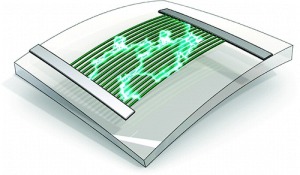by
Brendon Nafziger, DOTmed News Associate Editor | February 02, 2010

Artist's rendering of electricity-
generating rubber
Scientists at Princeton University have developed a flexible energy-producing rubber that could provide a long-lasting power source for pacemakers or other implanted medical devices.
As explained in a paper in a recent issue of Nano Letters, the scientists fit special substances called piezoelectric crystals into rubber sheets. These crystals respond to mechanical energy by creating electricity meaning, in the future, a pacemaker could be fueled by natural movements inside the body, such as the expansion of the lungs when you take a breath.
BREAKTHROUGH




Ad Statistics
Times Displayed: 30157
Times Visited: 744 Stay up to date with the latest training to fix, troubleshoot, and maintain your critical care devices. GE HealthCare offers multiple training formats to empower teams and expand knowledge, saving you time and money
While pieozoelectric crystals have been employed for ages - quartz is a naturally occurring pieozoelectic crystal - natural crystals are not very efficient generators of electricity. And though man-made pieozoelectric crystals, such as lead zirconate titanate, or PZT, the type used in this study, are 100 times more efficient than, say, quartz, they are rigidly inflexible, so not suited to many implantable devices, explains Michael McAlpine, assistant professor of mechanical and aerospace engineering and the senior author of the paper. Often they are not even biocompatible. After all, PZT contains lead, he notes.
"No one has been able to bridge the gap between high-performance rigid inorganic crystals and the low-performance flexible ones," McAlpine says. Until, perhaps, now.
HEAT SENSITIVE
Part of the trouble is that to crystallize, the substance requires searing high temperatures (600 degrees Celsius) that would ruin flexible but heat-sensitive materials like plastics or rubbers.
"If you take a milk bottle and put it at 60 degrees (Celsius), it's going to melt," says McAlpine.
To get around this, McAlpine's team hit upon a two-part solution. First, they heat-crystallized the PZT. Then, in a separate step, they printed it at room temperature onto a bendable rubber substrate.
This new power-making rubber, still largely in the conceptual stage, could stretch across many industrial, military and consumer applications. One that McAlpine mentions is putting the rubber-sheathed PZT in a car's shock absorber. The crystals then could absorb the "wasteful" mechanical energy from the car's vibrations, using it in turn, for instance, to juice the car's stereo.
And because the PZT is now encased in rubber, it would be biocompatible, and suitable for medical uses -- the most obvious being pacemakers. Batteries in the implantable cardiac devices generally wear out within five to 15 years, McAlpine notes, and patients have to undergo surgery to replace them. Piezoelectric crystals embedded in rubber in the device could change that, as they would continuously generate power when exposed to small, repeated stresses from breathing or other body motions.

